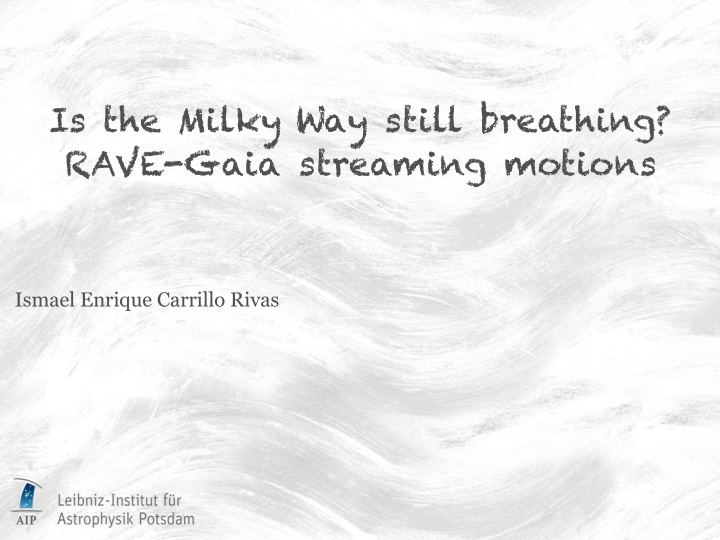



Is the Milky Way still breathing? RAVE-Gaia streaming motions Ismael Enrique Carrillo Rivas
Outline DECOMPOSITION OF THE VERTICAL Background VELOCITY PATTERN Milky Way disc asymmetries - - Galactocentric vertical velocity Breathing and Bending modes - - Galaxia mock RAVE sample Aims - - Components of Vz in the Williams/Kordopatis sample RAVE FIFTH DATA RELEASE RAVE-TGAS SAMPLE RAVE DR5 sample - Distance estimate - Vertical velocity - Distance estimate comparison - Gaia 's vertical streaming - motions
Background
Milky Way disc asymmetries To a first approximation, the Milky Way disc is assumed to be axisymmetric and in equilibrium. Asymmetries have gained importance due to: - High-quality spectroscopic and astrometric data (GCS, RAVE-TGAS, APOGEE-TGAS) - Volume expansion Indication of such asymmetries - Overdensities in the local velocity space (moving groups or streams, e.g., Dehnen (2000)) - Stellar streaming motions detected in the extended solar neighbourhood
Milky Way disc asymmetries 20 20 10 10 <V los .cos(b)> (km/s) <V los .cos(b)> (km/s) 0 0 − 10 − 10 − 20 − 20 0 1 0 1 d.cos(l).cos(b) (kpc) d.cos(l).cos(b) (kpc) Credit: Siebert et al. (2011)
Milky Way disc asymmetries Besides radial asymmetries, structure has been found also in the direction perpendicular to the Galactic disc. Radial velocity gradient - Internal perturbations Vertical velocity structure origins debatable: - Gomez et al. (2013): passing of the Sagittarius dwarf galaxy - Widrow et al. (2014): dark matter subhalo - Internal perturbations - Galactic warp
Breathing and Bending modes Williams et al. (2013) : <V Z > (km s − 1 ) − 30.00 − 15.00 0.00 15.00 30.00 - RAVE red-clump stars 2 a) RAVE - Compilation of proper motions 1 - Rarefaction-compression Z (kpc) 0 behaviour − 1 − 2 6 7 8 9 10 R (kpc) Credit: Williams et al. (2013) (modified)
Breathing and Bending modes Williams et al. (2013) : <V Z > (km s − 1 ) − 30.00 − 15.00 0.00 15.00 30.00 - RAVE red-clump stars 2 a) RAVE - Compilation of proper motions 1 - Rarefaction-compression Z (kpc) 0 behaviour − 1 − 2 Breathing mode: 6 7 8 9 10 R (kpc) - Odd parity in the vertical velocity distribution of stars Credit: Williams et al. (2013) (modified) - Even parity in the density distribution
Breathing and Bending modes Bending mode: - Even parity in the vertical velocity distribution of stars - Odd parity in the density Credit: Heidi Jo Newberg distribution
Breathing and Bending modes Credit: Erik Tollerud
Aims Extend Williams et al. (2013) analysis: - Combine Gaia DR1 with RAVE DR5 (Kunder et al. 2016) - Increasing the number of stars through inclusion of stars that are not in the red-clump - Using better proper motions and distance estimates - Study with higher accuracy the actual vertical velocity pattern of the extended solar neighbourhood.
RAVE FIFTH DATA RELEASE
RAVE FIFTH DATA RELEASE RAVE DR5 vs RAVE DR4: - Contains 520,781 spectra of 457,588 unique observed stars - Additional ~ 30, 000 RAVE spectra compared DR4 - Improves the distance pipeline of DR4, especially for the metal-poor stars - New calibration in its stellar parameters improving their accuracy by up to 15% compared to DR4 - With almost 256,000 spectra that overlap with a TGAS star, largest overlap with the TGAS catalogue in comparison to any spectroscopic survey to date.
RAVE DR5 sample Williams et al. (2013): - 72,635 red-clump stars obtained from the RAVE internal third data release - Compilation of proper motions catalogues based on their reported uncertainties Our sample: - Proper motions from the Tycho -2, PPMXL and UCAC4 catalogues - More homogeneous proper motions - Better distance estimates - More accurately derived velocities
Vertical velocity
Vertical velocity Observed dependence of vertical velocity on proper motions, points towards the need to use more accurate data. The ESA Gaia mission is thus crucial in understanding the origins of the vertical streaming motions observed in the Milky Way.
DECOMPOSITION OF THE VERTICAL VELOCITY PATTERN
Galactocentric vertical velocity
Galaxia mock RAVE sample = +
Galaxia mock RAVE sample = + The different Vb patterns dependent mainly on the proper motions, with the distance increasing its amplitude.
Components of Vz in the Williams/Kordopatis sample = +
RAVE-TGAS SAMPLE
Distance estimate The RAVE-TGAS sample makes use of the Astraatmadja & Bailer- Jones (2016) and and McMillan et al. (2017) distance estimates. Adopt the inverse parallax as the distance estimator, we encounter two important issues (discussed by Bailer-Jones (2015)): - (i) the estimator fails for negative , even though these are valid measurements (see Bailer-Jones 2015 for further details) - (ii) For fractional parallax errors using the inverse parallax creates a skewed distribution which gives a biased distance estimator.
Distance estimate comparison The consistency on the distance values between both estimates is very good. The right panel, however, shows that most stars have smaller relative uncertainties when using the Mcmillan estimate. Due to the consistency between the distance estimates we want to further study the ABJ distance uncertainties.
Distance estimate comparison Giants Cool Dwarfs Hot Dwarfs Ideally, the histograms would have a mean value of zero (no biases in one measurement versus another) and a dispersion of unity (consistent with the uncertainties being correctly estimated).
Gaia 's vertical streaming motions
Gaia 's vertical 6<R<6.5 streaming motions 6.5<R<7 7<R<7.5 7.5<R<8 8<R<8.5 8.5<R<9
Gaia 's vertical streaming motions In contrast to previous results suggesting a breathing mode perturbation, our analysis supports a combination of breathing and bending mode. Gaia DR2, which will both cover a significantly larger volume of the Milky Way disc and improve significantly the data systematics may solve the question whether the Milky Way is still just breathing.
Thank you for your attention!
Recommend
More recommend